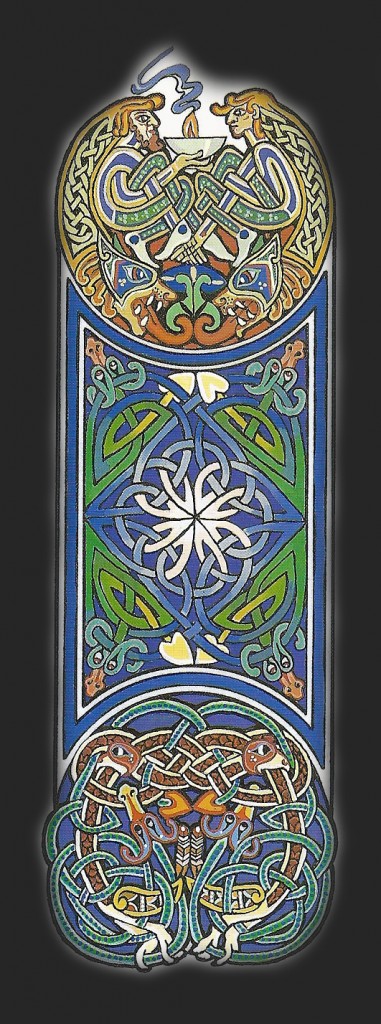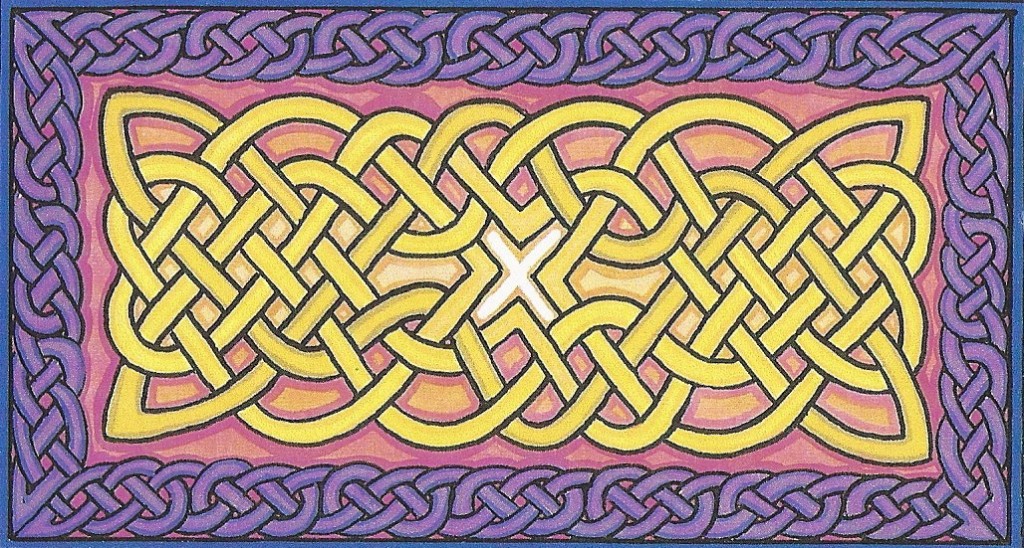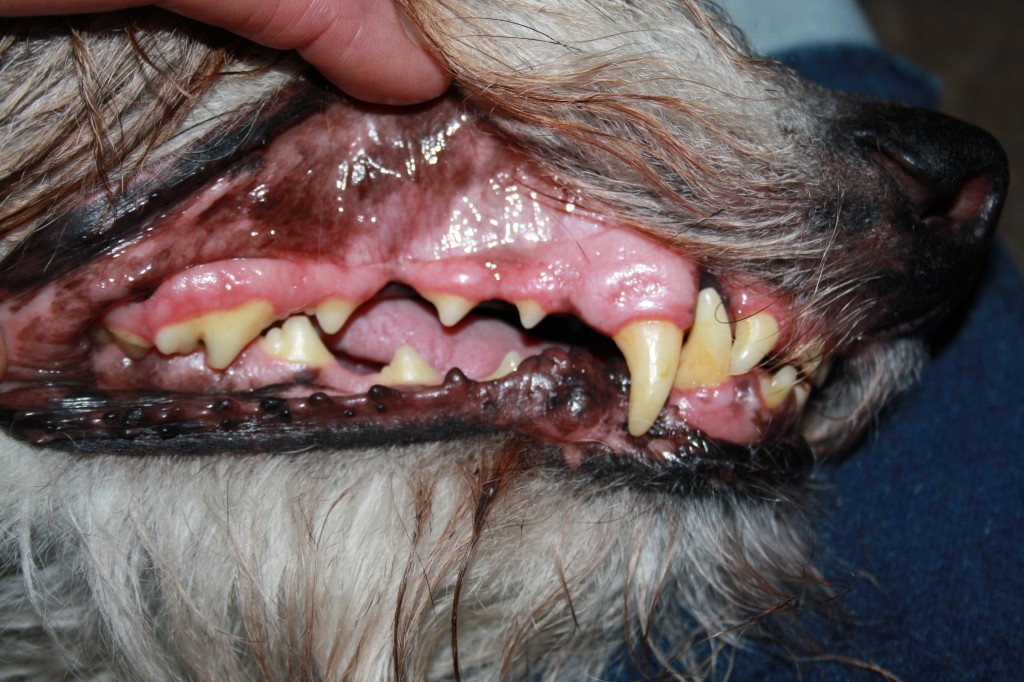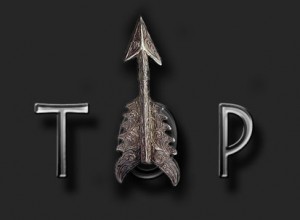 Nutrition and care.
Nutrition and care.
 Since we started with hounds in 1979, I always fed fresh meat. I have a strong anti-path against lumps, I find it unnatural and also boring for the hounds. Chunks give a lot of stools, letting the hound easily increase in weight and cause tooth paste with as a result tartar. Tartar causes inflammation causing bacteria to enter the bloodstream with all the consequences that entails. You also often see that the hound has an allergic reaction to one or more ingredients of the lump. All sorts of food combinations have been passed, including Dinner of dried cereals and vegetables with meat but currently I have been feeding fresh, (very fine) Gehakselde vegetables with meat, supplemented with the necessary nutrients such as lime (Gistocal), seaweed, salmon oil, wheat bran and if necessary bread, rice or macaroni. Oil is very important, these are essential fatty acids that the animal body can hardly create itself. It is important for the functioning of the muscles and body organs, maintaining the body temperature, storing and absorbing pigments and fat-soluble vitamins, stimulating hormone glands, protecting against growth and Reproductive disorders and supply and storage of energy. Deficiencies in essential fatty acids can express themselves in reduced propagation, hair loss, dry and flaky skin and poor wound healing. The vegetables I usually use are: carrots (good for eyes and heart), broccoli (against cancer), endive (lots of vitamins C), garlic (natural antibiotic, wormverdrijvend), red beets (vitamins C, rare trace elements), red cabbage (against Anemia, blood purifying, lots of vitamins C) and celery (reinforcing, vitamins E). Also parsley (good for the kidneys) and other herbs are very healthy. Occasionally, apples, bananas or other fruits go through it. The meat I feed is: ground chicken, chicken necks, old chicks, ground pens, tripe rags, lamb lung, konijnenmix, head meat, ground red meat (beef), turkey necks, salmon mix or chunks of salmon, whole herring/sardines. My Deerhounds are not charmed by, for example, whole chicken-hare carcasses or turkey wings, they find too big, too much work but of course there are hounds who like it. I chop the carcasses with a cleaver in pieces so they want to eat it. There are also regular cheeses, a raw egg and table leftovers. So they don't actually have the same day in their buckets and I am sure they will get all the vitamins and minerals. Of course it takes a bit more time to prepare but in terms of cost it will not avoid a lot of "excellent" chunk. Deerhounds can sometimes be very awkward eaters. Especially bitches can stop eating after the estrous cycle and keep it full for a long time. Some are to buy with some goodies about their practice, some really don't. What you can try is a can of tuna, salmon or sardines by doing their food. They also find pansy biscuits very tasty, I take the "ready" of the grocery store. Some grated cheese does wonders, similarly liver pies. A good shot of whole milk or coffee milk also wants to help. Those who like yogurt, quark or Hüttenkäse can be seduced by this. Where most hounds cannot resist, the Magic Meat balls are. It is always useful to have a stock of these in the freezer. Also the menu total change can work positively. If you are running meat normally, enter chunks or vice versa. But every now and then a few days not eating can really do any harm but please note that the Hound really does not get anything else to eat/candy because, as with people, snacks are really disastrous. If it is really too long that your hound does not eat, then feeding is necessary. Our greyhounds have few reserves of nature and are therefore quickly exhausted. First Just eat from the hand, this does not work then open the beak, take small clog feed in the hand and let it glide behind in the beak. Make sure the feed is wet so it can glide too! Keep the mouth shut and possibly massage the throat so that it is swallowed but when the food is well in the back, they usually do it by itself. Some are very easy in this, others do not accept this and make sure that it becomes a gigantic mess! The best remedy for poorly eating bitches is still sterilization. However, you should make sure that the hound gets about 1/3 of its normal portion, which is more than enough. This money also for castrated males. If it is a male or sterilized bitch who does not want to eat, then daily more movement is the only thing that can be a solution. How do you know if your Deerhound is too skinny or too thick. This one can feel best at the widest point of the ribs party (seen from above). Too thick is easy, if you can't feel a rib anymore, your hound is really too thick. If you can pick/include any rib, your Deerhound is too skinny. (Similarly, the thorns of the vertebrae protrude too much). You should be able to feel every rib well without pressing it too hard, the last two/three ribs can make you feel clearer.
Since we started with hounds in 1979, I always fed fresh meat. I have a strong anti-path against lumps, I find it unnatural and also boring for the hounds. Chunks give a lot of stools, letting the hound easily increase in weight and cause tooth paste with as a result tartar. Tartar causes inflammation causing bacteria to enter the bloodstream with all the consequences that entails. You also often see that the hound has an allergic reaction to one or more ingredients of the lump. All sorts of food combinations have been passed, including Dinner of dried cereals and vegetables with meat but currently I have been feeding fresh, (very fine) Gehakselde vegetables with meat, supplemented with the necessary nutrients such as lime (Gistocal), seaweed, salmon oil, wheat bran and if necessary bread, rice or macaroni. Oil is very important, these are essential fatty acids that the animal body can hardly create itself. It is important for the functioning of the muscles and body organs, maintaining the body temperature, storing and absorbing pigments and fat-soluble vitamins, stimulating hormone glands, protecting against growth and Reproductive disorders and supply and storage of energy. Deficiencies in essential fatty acids can express themselves in reduced propagation, hair loss, dry and flaky skin and poor wound healing. The vegetables I usually use are: carrots (good for eyes and heart), broccoli (against cancer), endive (lots of vitamins C), garlic (natural antibiotic, wormverdrijvend), red beets (vitamins C, rare trace elements), red cabbage (against Anemia, blood purifying, lots of vitamins C) and celery (reinforcing, vitamins E). Also parsley (good for the kidneys) and other herbs are very healthy. Occasionally, apples, bananas or other fruits go through it. The meat I feed is: ground chicken, chicken necks, old chicks, ground pens, tripe rags, lamb lung, konijnenmix, head meat, ground red meat (beef), turkey necks, salmon mix or chunks of salmon, whole herring/sardines. My Deerhounds are not charmed by, for example, whole chicken-hare carcasses or turkey wings, they find too big, too much work but of course there are hounds who like it. I chop the carcasses with a cleaver in pieces so they want to eat it. There are also regular cheeses, a raw egg and table leftovers. So they don't actually have the same day in their buckets and I am sure they will get all the vitamins and minerals. Of course it takes a bit more time to prepare but in terms of cost it will not avoid a lot of "excellent" chunk. Deerhounds can sometimes be very awkward eaters. Especially bitches can stop eating after the estrous cycle and keep it full for a long time. Some are to buy with some goodies about their practice, some really don't. What you can try is a can of tuna, salmon or sardines by doing their food. They also find pansy biscuits very tasty, I take the "ready" of the grocery store. Some grated cheese does wonders, similarly liver pies. A good shot of whole milk or coffee milk also wants to help. Those who like yogurt, quark or Hüttenkäse can be seduced by this. Where most hounds cannot resist, the Magic Meat balls are. It is always useful to have a stock of these in the freezer. Also the menu total change can work positively. If you are running meat normally, enter chunks or vice versa. But every now and then a few days not eating can really do any harm but please note that the Hound really does not get anything else to eat/candy because, as with people, snacks are really disastrous. If it is really too long that your hound does not eat, then feeding is necessary. Our greyhounds have few reserves of nature and are therefore quickly exhausted. First Just eat from the hand, this does not work then open the beak, take small clog feed in the hand and let it glide behind in the beak. Make sure the feed is wet so it can glide too! Keep the mouth shut and possibly massage the throat so that it is swallowed but when the food is well in the back, they usually do it by itself. Some are very easy in this, others do not accept this and make sure that it becomes a gigantic mess! The best remedy for poorly eating bitches is still sterilization. However, you should make sure that the hound gets about 1/3 of its normal portion, which is more than enough. This money also for castrated males. If it is a male or sterilized bitch who does not want to eat, then daily more movement is the only thing that can be a solution. How do you know if your Deerhound is too skinny or too thick. This one can feel best at the widest point of the ribs party (seen from above). Too thick is easy, if you can't feel a rib anymore, your hound is really too thick. If you can pick/include any rib, your Deerhound is too skinny. (Similarly, the thorns of the vertebrae protrude too much). You should be able to feel every rib well without pressing it too hard, the last two/three ribs can make you feel clearer. 
The ones that need it, like older hounds, get nutritional supplements. You can achieve remarkable results with these resources. Cholodin is good to keep a hound mentally fit, Cosequin for osteoarthritis in the joints and L-carnitine for muscles, so also the heart muscle!
Partly because of the meat nutrition, I have to clean almost no teeth, it is seldom that a small edge plaque has arisen. Even grandma Amy had no dirty teeth at twelve and a half age! Also fleas and worms I come to our hounds never against thanks to the garlic. Against sign I have to protect them, I use Defendog, with my hounds the most effective.
Grandma Amy, Elf and half a year young a Deerhound is thus a wirehaired hound. This means that the hair of the fur has a length of 8 to 10 centimeters and that the fur looks tousled and feels stiff. Under this stiff, protective coat is an undercoat of shorter and softer hair that keeps the body at the right temperature. It is sufficient to have a coarse comb once a week, then with a fine comb or special brush for the dead hair and possibly with a bristle bristle brush through the fur to go. Beg at the hind feet and work from bottom to top and from back to front the entire hound. Also under the tail and tail itself, between the legs and under the armpits. These are places that first go tangles, nice warm and therefore the ideal place for pests! The hair between the toes must be checked regularly. I keep it quite short, this makes for less dirt in the house and you can better see if there are injuries between the toes. The long hair on top of the toes I pick away with thumb and index finger, so that a beautiful foot arises. The nails, do not forget the thumbs, should be cut regularly. I also file the nails, I do so that they are not too painful for a loving hug. It depends on how much the hound runs on a stone surface and at the one hound they grow harder than the other, but make sure they don't get too long, long nails can cause sagging feet and that is out of the question. Good foot care is very important! In the bitch, you may want to cut off the excess hair around the vulva, which is more hygienic and easier to maintain. The male is the same for the hair at his piemeltje, keep them short and make sure he does not get voorhuid inflammation by rinsing it regularly with a voorhuid cleaner that can be obtained from the vet. It is really dirty and unkempt if it is not maintained. Deerhounds have little trouble with their ears, but they keep an eye on them when they run through the ploughed fields on a regular basis. Regularly see if they are still clean and they possibly clean with a wad of cotton soaked in sunflower oil can prevent problems. You also need to remove the long hair from the ear canal occasionally, not cut!!! Because then the hair can fall into the ear canal with nasty consequences. With thumb and index finger you pull them out like this. Stink the ears or is there an excessive brown discharge that goes with kopschudden and crabs, then to the vet. If you have show plans you can best pick the ears a week before the show. With thumb and index finger the longer hair, nearly one by one, in the growth direction pull out there. If the hair is "old" enough, The Hound hardly feels anything and it is a matter of getting used to. Just as long as you pick up beautiful "mice skins". Always keep an eye on the eyes, aren't they red and/or watery? Is there no dirt in it? If there are e.g. Sand has come in you can rinse them with boiled water but they are red and/or watery, then to the vet. I have more or less had the teeth, keeping them clean is the motto. And… nothing is worse than a hound that stinks terribly out of his beak! So it is very important that, as soon as you have the puppy in your house, you get used to it that you are very regu lar with a toothbrush in his beak. Do not allow him to bite and see it as a game. Be strict here, you will only benefit from it later. There are now very good "dogs Tandpasta's" for sale but if you are using fresh meat and fresh bones, you will notice that the teeth need no or hardly any maintenance.
lar with a toothbrush in his beak. Do not allow him to bite and see it as a game. Be strict here, you will only benefit from it later. There are now very good "dogs Tandpasta's" for sale but if you are using fresh meat and fresh bones, you will notice that the teeth need no or hardly any maintenance.
Here you see the teeth of our twelve and a half year old Amy. It was now a bit discolored and worn, but I hadn't done anything about it in recent months.
The body temperature of a Deerhound can be slightly lower than normal dogs. So against the 38 degrees Celsius. But as soon as the temperature rises through disease, you notice this directly to the hound. Just above the 38.5, they are often already a model of misery. Fever in itself is of course not bad, the body is contrary to the germs but if the temperature is too much, my border is at 40, you have to do something to prevent damage. A good way to get the temperature down quickly is to wrap the feet and lower part of the legs with icy rags. But of course this does not mean that you don't have to visit a vet anymore! Incidentally, I advise you to insure your hound against health costs. For a good antibiotic cure, you can spend a lot more on a Deerhound than a butterfly dog.
If the food is good, they are regularly combed and their cribs are regularly changed Deerhounds have absolutely no nasty body odor, even if they are wet! So in bad they never go with me, only if it is really necessary after e.g. A rolpartij in a cow flan or rotten fish. After a heavy rain, they dry off with a large towel and they are clean again!
A well-groomed Deerhound is a feast for the eye, a badly cared-for Deerhound soon looks totally neglected.
